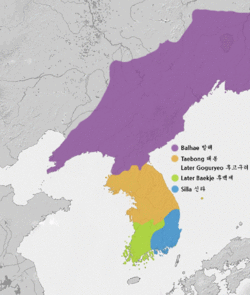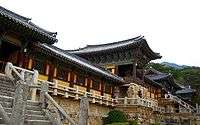Later Three Kingdoms
| Later Three Kingdoms | |
 | |
| Korean name | |
|---|---|
| Hangul | 후삼국시대 or 후삼국 시대 |
| Hanja | 後三國時代 |
| Revised Romanization | Husamguk Sidae |
| McCune–Reischauer | Husamguk Sidae |
Part of a series on the |
||||||||
|---|---|---|---|---|---|---|---|---|
| History of Korea | ||||||||
 | ||||||||
| Prehistory | ||||||||
| Ancient | ||||||||
| Proto–Three Kingdoms | ||||||||
| Three Kingdoms | ||||||||
|
||||||||
| North–South States | ||||||||
|
||||||||
| Later Three Kingdoms | ||||||||
|
||||||||
| Unitary dynastic period | ||||||||
|
||||||||
| Colonial period | ||||||||
|
||||||||
| Division of Korea | ||||||||
|
||||||||
| By topic | ||||||||
| Timeline | ||||||||
|
| ||||||||
The Later Three Kingdoms of Korea (892–936) consisted of Silla, Hubaekje ("Later Baekje") and Hugoguryeo ("Later Goguryeo", it was replaced by Goryeo). The later two claimed heirs to the earlier Three Kingdoms of Korea, which had been united by Silla, even though Hugoguryeo has little to do with Goguryeo. This period arose out of national unrest during the reign of Queen Jinseong of Silla, and usually refers to the era between the founding of Hubaekje by Gyeon Hwon to the time Goryeo unified the peninsula.[1]
Background
In the 9th and 10th century, Silla was shaken by problems arising from its reliance on the "bone rank system", a rigid class system under which only those from an aristocratic background could be appointed to high office. The system was being abused as a means for the ruling royal family to dominate politically and this caused much unrest in the latter days of Silla. The local gentry called hojok (hangul:호족, hanja: 豪族), i.e. mid-level nobility or village chiefs, strengthened their power during this chaotic period by assembling armies of their own and independently centralizing their forces.[2] Dissention deepened within the nobility after the death of King Hyegong as contention over the royal succession intensified and power struggles were constant among the hojok. Not only was the political atmosphere in a shambles, the financial state of Silla was dire. Taxation was difficult without the nobles' cooperation. As a result, the tax burden fell heavily on the peasants and farmers, who consequently revolted in 889, the third year of Queen Jinseong's reign. Numerous revolts and uprisings occurred during the following 100 years, breaking Silla down.[1]
Hubaekje and Hugoguryeo
As Silla started to crumble, Gyeon Hwon, a former general of Silla, led rebel troops to seize the provincial capital of Mujinju (hangul:무진주, hanja:武珍州), today's Gwangju in 892. He then conquered the southwest regions and in 900, Gyeon Hwon declared himself king of Hubaekje ("later Baekje"), a country to revive Baekje's glory. He established his capital at Wansanju (hangul:완산주, hanja:完山州), today's Jeonju, and continued to expand the kingdom.[1][3]
Gung Ye from Silla is believed to come from a royal or noble background.[4] He was a Buddhist monk but soon joined in the political uprisings, and became leader of many troops. He conquered much land and set up base in Myeongju (hangul:명주, hanja:溟州), today's Gangneung in 895 with the support of many regional leaders, including general Wang Geon. In 901, Gung Ye founded Hugoguryeo but changed the name to Majin in 904, and moved the capital to Cheorwon. He changed the name to Taebong in 911.[1][5]
Unification of the later three kingdoms
Although Hubaekje started out as the frontrunner in national strength thanks to its fertile plains and diplomatic ties with China, Hugoguryeo soon became the largest force in the new three kingdom era as it quickly expanded its territory to almost three quarters of the peninsula under Gung Ye and the general Wang Geon. As time passed however, Gung Ye started to call himself the Maitreya Buddha and resort to despotism, causing him to be overthrown by Wanggeon in 918.[1][6] Wanggeon established a new dynasty called Goryeo and moved the capital to Songak (hangul:송악, hanja:松嶽) the following year, creating the new troika of Goryeo, Baekje and Silla.[7]
The three kingdoms were in a constant power struggle, although by this time Silla had weakened to a despondent state and did not pose much of a threat to the other two nations. Hubaekje led with an offensive approach but Wanggeon of Goryeo placed more importance on diplomatic ties, which endeared his kingdom to Silla.[1] The conflict between Hubaekje and Goryeo was constant near Silla territory, as both countries wanted to wield their power over the region. Hubaekje led by attacking Gyeongju, the capital of Silla, in 927 and crushing the Goryeo army.[8] Goryeo retaliated by winning the battle at Gochang in 930 and reclaiming the territory of Woongjin in 934.[1]
In 935, King Gyeongsun of a very weakened Silla surrendered to Goryeo. During this time, inner power struggles within Hubaekje weaken a country already fatigued from warfare. Gyeon Hwon named his youngest son Geumgang as heir, but his other sons (by a previous wife) joined forces and rebelled, placing Gyeon Hwon's eldest son Singeom on the throne and confining Gyeon Hwon to Geumsan Temple. Gyeon Hwon later escaped to Goryeo and joined forces with Wanggeon's army to attack the very country he founded. Hubaekje fell to Goryeo in 936 and the peninsula was reunified.[8]
See also
- List of Korea-related topics
- Silla
- Baekje
- Taebong
- Hubaekje
- Later Sabeol
- Gyeon Hwon / Gung Ye / Wanggeon
Notes
- 1 2 3 4 5 6 7 "Later three kingdom era", Encyclopedia of Korean Culture (in Korean), Nate.
- ↑ Korea through the Ages, 1, pp. 99–103.
- ↑ "Gyeon Hwon", Doosan Encyclopedia (in Korean), Naver.
- ↑ "Gung Ye at The Academy of Korean Studies". people.aks.ac.kr. Retrieved 7 March 2011.
- ↑ (Korean) Taebong at Doosan Encyclopedia
- ↑ Korea through the Ages Vol. 1 pp 110-113
- ↑ (Korean) Goryeo Taejo at Doosan Encyclopedia
- 1 2 Korea through the Ages Vol. 1 p113
References
- The Academy of Korean Studies, Korea through the Ages Vol. 1, The Editor Publishing Co., Seoul, 2005. ISBN 89-7105-544-8